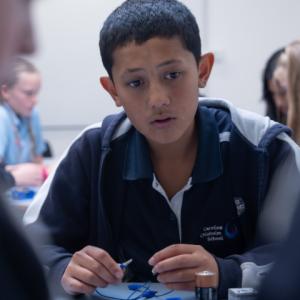Cultivating a questioning culture
Why cultivate a questioning culture?
The Primary Connections approach to the teaching of science emphasises the important role of students’ questions as a creative driver of the inquiry process. Students are encouraged and scaffolded to identify and construct questions in response to real-world experiences and contexts.
Students’ questions can be expressions of their existing knowledge, reasoning, assumptions, doubts, curiosity and wonder, and interest and motivation to learn. As such, they can provide useful diagnostic information to teachers about students’ current beliefs and perspectives, and gaps and inconsistencies in their knowledge. Students’ questions are useful for driving dialogue, engaging students in the social construction of new understanding.
Students are more likely to ask questions when:
- they have been explicitly taught what questions sound like, look like, and how to ask questions.
- they are learning in an environment of psychosocial safety, in which it is assumed that they do not know everything, that they can express doubt and curiosity, and are encouraged to explore problems before solving them.
- their questions are welcomed and treated as genuine requests to express wonder, extend their understanding, resolve doubt, or solve problems.
- there are plenty of opportunities for students to ask questions; spontaneous, planned, and ongoing.
Students are less likely to ask questions when:
- there is no space or time to ask questions.
- the vast majority of questions asked are asked by the teacher rather than the students.
- they are generally expected to know the answers to questions asked in the classroom.
- their questions are regularly dismissed or ignored.
How do we cultivate a questioning culture in the classroom?
It is important to value students’ questions, and as appropriate, scaffold students to explore and identify resolutions. Sometimes students ask questions when there is no space or time to resolve them; questions can be “parked” and returned to when space and time is available. Here are some suggestions for strategies to cultivate a questioning culture in the classroom:
- Use a TWLH process for documenting learning across an inquiry.
- Make space and time for questions by scheduling time during and around lessons for questions.
- Develop criteria with students around “good” or “useful” questions and recognise and reward these questions.
- Model questions and questioning. A Q-matrix provides question stems that can help students who may be struggling to develop questions of their own.
- Stimulate questions by providing prompts and provocations that target specific learning goals and contexts. The Question Formulation Technique provides a method for generating and improving questions using stimuli.
- Give feedback to questions, at the right time and in appropriate formats for students’ ages and learning context.
- Ask “what questions do you have?” instead of “do you have any questions?”
- Provide spaces for questions, such as parking lots on desks or on the wall, a question mailbox by the door, or include opportunities for questions in classroom exit procedures.
Remember that students are more likely to ask more questions, and improve the quality of their questions, when they feel that their questions will be welcomed and treated with respect.
Discuss with your colleagues
Describe a time when students asked a lot of questions in the classroom.
Describe a time when students struggled to ask questions in the classroom.
Compare the classroom conditions in both situations. How were the two situations the same/different?
Discuss:
- How could/do you make time for questions in your classroom?
- How could/do you respond to questions that need an immediate answer?
- What types of questions need an immediate answer?
- How could/do you respond when you receive several questions at once?
- How could you encourage students to ask more questions?
References
Chin, C. & Osborne, J. (2008). Students' questions: A potential resource for teaching and learning science <https://www.tandfonline.com/doi/full/10.1080/03057260701828101>. Studies in Science Education, 44(1), 1-39.
Herranen, J., & Aksela, M. (2019). Student-question-based inquiry in science education <https://www.tandfonline.com/doi/abs/10.1080/03057267.2019.1658059>. Studies in Science Education, 55(1), 1-36.
Santana, L. & Rothstein, D. (2018). The Question Formulation Technique. Retrieved from http://rightquestion.org/. Massachusetts: The Right Question Institute.
Wiederhold, C. W. & Kagan, S. (2007) Cooperative learning & higher-level thinking: the Q-matrix <https://www.kaganaustralia.com.au/shop/cooperative-learning/cooperative-learning-higher-level-thinking/>. Hawker Brownlow Education.

